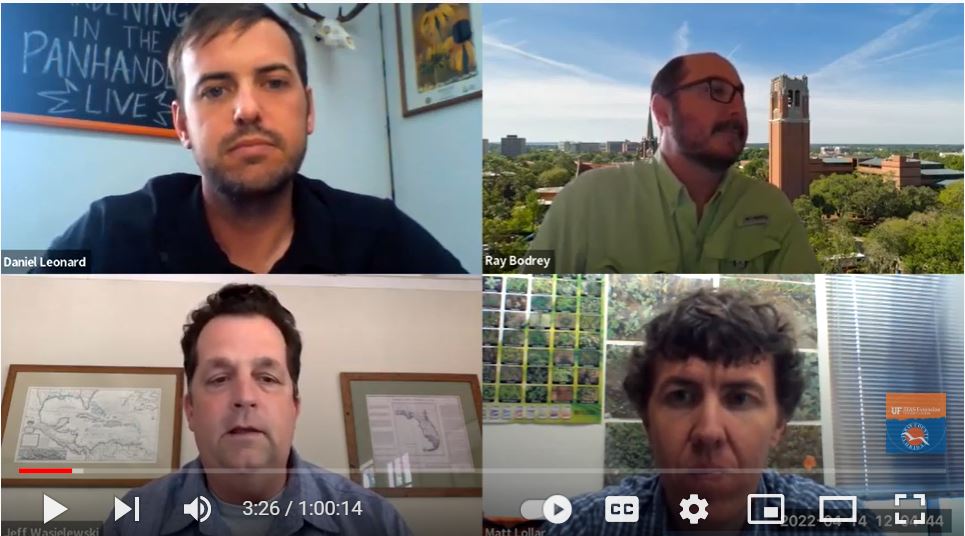
by Beth Bolles | May 26, 2022
The Q&A on Subtropical Fruits offered valuable information on many types of subtropical and temperate fruits of interest to homeowners. Below are the reference materials related to specific questions that were asked along with notes from the panel discussions.
How to protect tropical and subtropical fruit trees from freezes?
Freeze protection of TF crops outside of Miami-Dade County: https://www.youtube.com/watch?v=e1U7CrqX074
Cold protection in South Florida is mainly through irrigation practices. It takes irrigation to run before freeze and continue until freeze is over.
What are the easiest subtropical fruits to grow?
Loquat: https://edis.ifas.ufl.edu/publication/MG050
Home Citrus Culture Publications – UF: https://edis.ifas.ufl.edu/entity/topic/citrus_home_citrus_culture
What are the best citrus trees to grow on NE Florida?
Tangerine, Mandarin (Owari and Brown select mandarins), & Tangelo Varieties: https://edis.ifas.ufl.edu/entity/topic/tangerines_mandarins_tangelos
Can we grow papayas here?
Growing Papaya in the Home Landscape: https://edis.ifas.ufl.edu/publication/MG054
Papayas are grown from a seed, not from air layering or grafts. There are some disease issues from Papaya ringspot virus. May have to start new plants. Less than a year from seed to fruit. Seed can be all male, all female, or have both male and female flowers. Need to get rid of the males. Male flowers hang off the tree where females stick to the stem more.
What are the best varieties of limes to grow in the Panhandle?
Growing “Tahiti” Limes in the Home Landscape: https://edis.ifas.ufl.edu/publication/CH093
Tahita and Persian limes are in retail nurseries. These are cold sensitive so plant in protected areas. Key limes would need to be in a container for most people.
Rangpur lime is a lemon and mandarin cross.
Bananas continually produce nice foliage but do not form fruit in 5 years. What to do?
Maybe not spend any more time trying to get fruit. If the bananas are in a large clump, you don’t want to have a large clump. Cut them back so that you have 3 bananas, one large, one medium, and one small so that you get lots of light. That is the key to fruit. Remove brown leaves.
Can we grow a Barbados cherry successfully?
Malpighia glabra, Barbados Cherry: https://edis.ifas.ufl.edu/pdf/FP/FP39000.pdf
Small tree to about 6 feet x 6 feet. Mild flavor. Not really suitable for North Florida. Needs sunlight for fruit.
Can we get the transgenic papaya that is immune to the Ringspot virus?
TREC Fruit Specialist has the papaya but it is not legal to introduce them into Florida at this time.
Advice on growing kiwi vine.
Growing Kiwis in FL: https://nwdistrict.ifas.ufl.edu/hort/2019/04/09/kiwis-a-golden-opportunity/
Temperate fruit that requires chill hours. Golden varieties developed by Auburn University. AU Golden Dragon and AU Golden Sunshine. Need a substantial trellis. Male and female vines so male vine for every 2-3 females.
Crestview gets fairly cold in late winter. What fruit trees do well here?
Dooryard Fruit Varieties: https://edis.ifas.ufl.edu/pdf%5CMG%5CMG24800.pdf
Will Papaya fruits reach maturity in NW Florida?
Growing Papaya in the Home Landscape: https://edis.ifas.ufl.edu/publication/MG054
Papayas do not like the cold. Probably not likely to produce a fruit but can give it a try.
What about pineapples?
Good option in a container. Bromeliad that is terrestrial that is watered through the roots.
I planted an arbequina olive tree and it’s struggling. Keeping in pot and protected from freezing but not thriving.
Olives for Your FL Landscape: https://edis.ifas.ufl.edu/publication/EP515
Olives like a more consistent temperature than the Panhandle offers. Needs excellent drainage.
Mexican avocado has survived freeze and flooding but still not thriving. Why?
Avocado IPM: https://trec.ifas.ufl.edu/tropical-entomology/index.php
Hass avocado, smaller ones from CA and Mexico. South Florida is too warm to grow Hass but it may work in North Florida. Green skinned avocado is grown in South Florida. More tasty. Florida avocados need a little cool weather to initiate flower and then fruit.
Avocados will not like wet soils.
Will lychee and avocado grow in Pensacola?
Red fruit, white inside, similar to a grape but sweeter. Needs chill hours. 2018 lychee mite came into Florida and now in 13 counties. Difficult to manage.
Shade-tolerant subtropical fruits?
Fruit needs sun. Monstera deliciosa, Swiss cheese plant, produces an edible fruit grows in shade. Definitely needs protection. DO NOT eat fruit early or you will have mouth pain. Fruit should be falling apart.
Pawpaw is not tropical but grows in shade.
How to trim fruit trees?
Hand pruning and training of tropical and sub tropical fruit trees: https://edis.ifas.ufl.edu/publication/HS1372
Often prune for size control in South Florida to encourage lateral growth and get sunlight into the center.
Which banana trees thrive here?
Banana Growing in the Florida Home Landscape
https://edis.ifas.ufl.edu/publication/MG040
What subtropical fruits are garnering the most interest in the panhandle right now?
Loquat Growing in the Florida Home Landscape: https://edis.ifas.ufl.edu/publication/MG050
Mangos are of most interest in South Florida
What about akee?
Caribbean fruit related to lychee. Do not eat before ripe or you will die.
The good pH for blueberries and raspberries
Blueberry Gardener’s Guide: https://edis.ifas.ufl.edu/publication/MG359
What plum varieties are recommended?
Fruit Tree Recommendations for AL: https://ssl.acesag.auburn.edu/pubs/docs/A/ANR-0053-F/ANR-0053-F-archive.pdf
Finger limes are the new hot crop at the TREC.
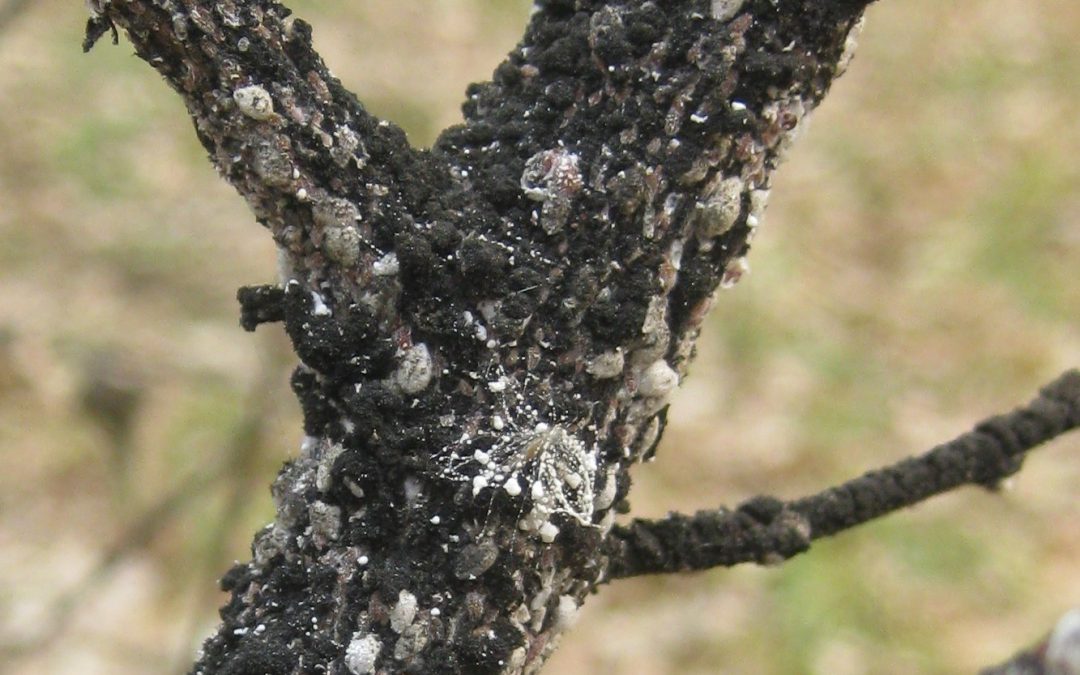
by Matthew Orwat | Feb 17, 2022
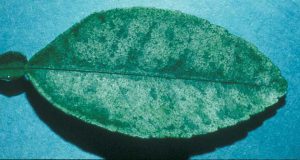
Citrus red mite leaf damage, red mites may overwinter, but are susceptible to control by dormant oil. Image UF / IFAS HS-806
During cold winter weather, one doesn’t often think about spraying fruit trees and ornamental shrubs for spring insects and diseases. It’s just not on the radar, but it turns out that January and February are the best time to apply dormant sprays to combat insect and disease issues. Many ask, “What are dormant sprays”?
Dormant sprays act on insects or disease pathogens differently. Many insects overwinter on trees and shrubs, either as eggs or immobilized in a protective shell (scale insects). Horticultural oils applied during cool dormant conditions work by smothering the eggs of some insect species or encapsulated scale insects. Since they cannot breathe, they die.
On the other hand, dormant sprays containing copper or sulfur actually kill latent fungal spores that are ready to infect the moment weather warms. They also burn tender young plant tissue, so can only be used when the plant is not actively growing. These preventative sprays can delay disease incidence in early spring and allow for reduction or elimination of regular fungicide applications. The old adage “an ounce of prevention is worth a pound of cure” surely applies to these situations.
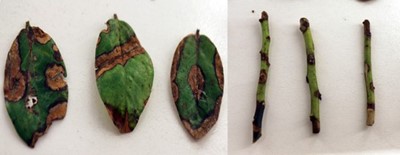
Phomopsis leaf and stem symptoms. Dormant fungicide sprays may lessen the severity of this disease.
Credit: N. Flor, UF/IFAS
There are several products on the market for dormant applications.
Dormant oil is a type of horticultural oil, made of refined petroleum products, for application on trees or shrubs when the trees are not actively growing. It has been in use for over 100 years. They are effective in the suppression of scale insects and mites. Care must be used to not apply them when daytime temperatures are above 75 degrees or night temperatures below 28 degrees. Other horticultural oils exist that may be applied during the growing season to control soft-bodied insects, but not during extremely hot weather. Many different brands exist, some are certified organic. They can be purchased at most garden centers, but the best selection is usually found at your independent nursery or farm store.
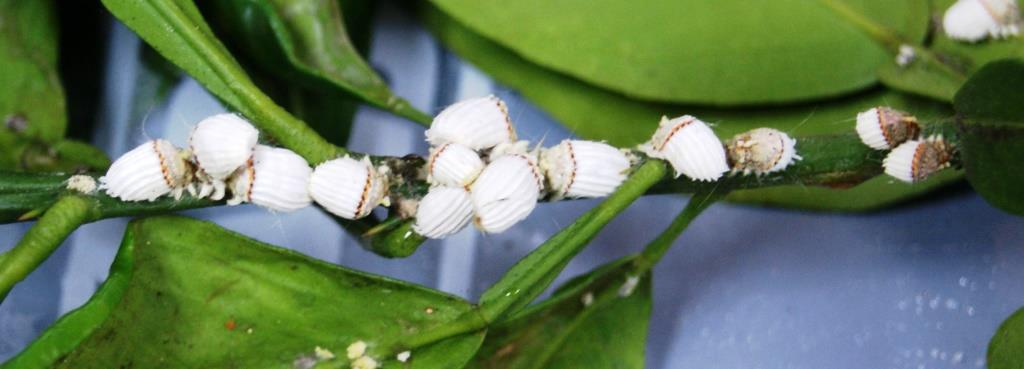
Cottony Cushion Scale, often controlled by Dormant Horticultural Oil. Image Credit, Matthew Orwat, UF / IFAS Extension
Dormant fungicides can be classified into two groups. Those that contain copper and those that contain sulfur. The most common preventative remedy for fungal disease had been lime-sulfur. It is no longer available in small home garden quantities due to shipping container restrictions, it can be purchased online in larger quantities for use in Florida. When applied to dormant plants, lime sulfur actually works by sanitizing the stem, killing all fungal spores. It cannot be used during the growing season since it burns leafy tissue. Caution must be taken when mixing and loading since, being an acidic product, can burn the skin. Wear chemical resistant gloves when applying (bought at your local hardware store for $4.00-$10.00), safety goggles and follow all label directions carefully since it is caustic and labeled DANGER. Also, never apply lime-sulfur within one month of horticultural oil applications. It should be applied in early to mid February, avoiding hard freezes for the 24 hours around application time. Sulfur based fungicide sprays may also be used instead of Lime-Sulfur as a dormant application.
Dormant copper sprays are effective on both bacterial and fungal pathogens and used primarily on fruit crops for the suppression of many fruit diseases including fire blight, bacterial leaf spot, powdery mildew, downey mildew and anthracnose. There are several different brands of copper fungicide preparations on the market, most nurseries and garden supply centers will have some in stock. Always read the label for proper personal protective equipment and dosage rates, to avoid copper buildup in the soil over time.
For more information, contact your local extension agent or consult these extension publications from: Disease Management Strategies, Florida Blueberry Disease Guide and Pest Control Using Horticultural Oils .
This article was originally published on January 2016, and has been modified to reflect current information.
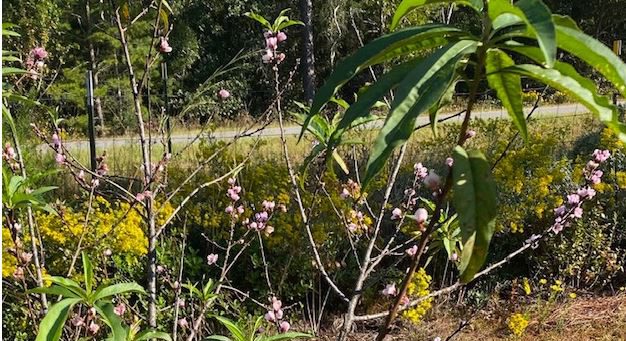
by Larry Williams | Nov 4, 2021
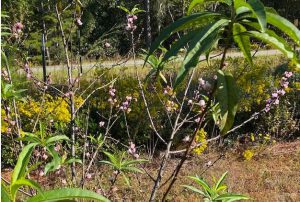
Peach tree blooming in fall. Note the yellow fall flowers of goldenrod & aster blooming in background. Photo credit: Leslie Hauquitz
Some fruit trees that normally bloom in late winter and spring are blooming now. Recently, a lady who had been out of town noticed that her peach trees were blooming when she arrived home. Knowing that peach trees ordinarily bloom around spring, she called me about this unusual occurrence. This unseasonal flowering also is occurring on some other fruit trees such as crabapple, apple and pear. This phenomenon also can occur in other deciduous spring flowering trees such as Japanese magnolia.
Anything that results in the leaves falling earlier than normal can result in this blooming out of season. Stresses that can result in the leaves falling prematurely include late season storms, insects and foliage diseases. This year’s excessive rains favored foliage diseases resulting in early leaf drop in many trees.
During most years, normal leaf drop in these trees occurs later in the season as the day length becomes shorter and when temperatures are cooler. Cooler temperatures prevent the flower buds from swelling and opening. However, if the leaves fall when the day length is longer and the temperature is warmer, the flower buds will swell and open. The leaves prevent the flower buds from developing. If the leaves fall early, during late summer or early fall, the flowers are allowed to open. With commercial apple production in some parts of the world, chemicals are applied to intentionally remove the leaves to force a second crop after harvesting the first crop of apples. This practice would not work in our area because there is not enough time to mature a second crop of fruit before cold weather arrives.
It is possible for a second crop of small fruit to develop on fruit trees that are blooming now as a result of the second flowering this year. However, because of the colder weather that will be arriving as we move into winter, any such fruit will not have time to mature. When the first killing frost or freeze occurs, these young fruits will be killed.
The lady who called about her peach trees wanted to know if she should remove the flowers and if this late flowering would negatively impact next spring’s flowering and fruit production. The flowers that opened this fall will be absent in spring – reducing the total number of flowers. However, during most springs, fruit trees produce more blooms and subsequently fruits than the trees can support. As a result, this unseasonable blooming should result in a needed thinning in next spring’s fruit crop.
So, there’s no need to remove them…just enjoy this “surprise” flower show.
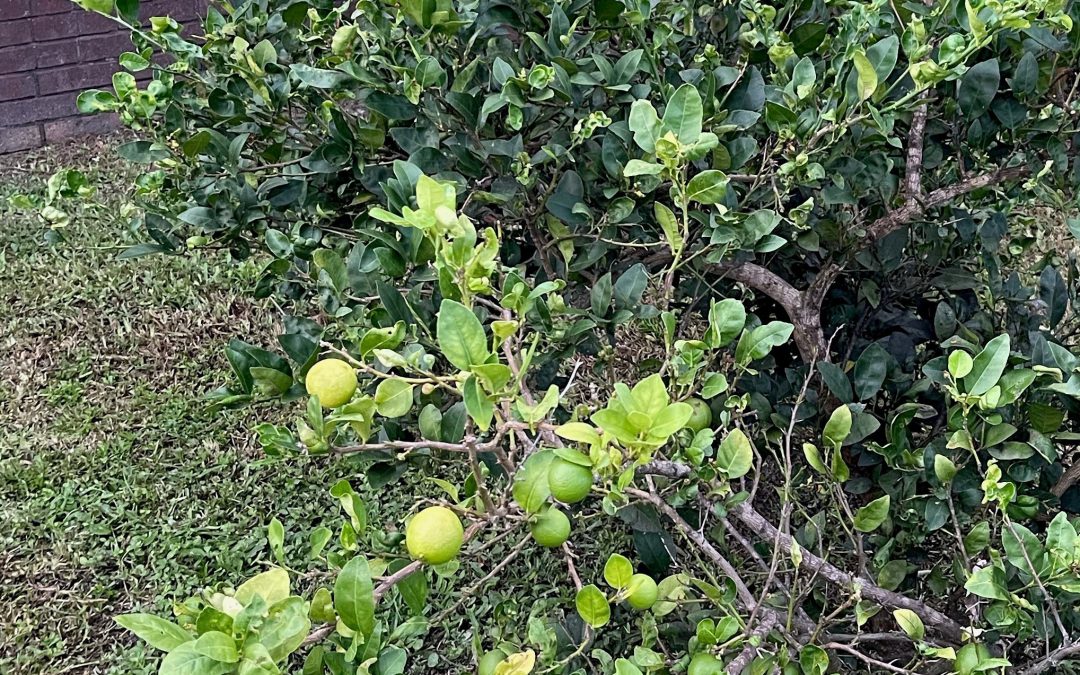
by Ray Bodrey | Sep 9, 2021
Growing Key Limes in the home landscape is not only a fun and unique addition, but is also delicious – any way you slice them.
The key lime, Citrus aurantifolia, originated in southeast Asia. Genetically speaking, the key lime is likely a tri-hybrid cross between the “odd ball fruits”, known as citron, pummelo and a microcitrus species, Citrus micrantha. There is little commercial key lime production nowadays in Florida, but the fruit remains a very popular landscape option.
The key lime is a small, bushy tree that makes harvest and pruning a breeze. Like most citrus, it’s self-pollinating. The key lime is also an ever-bearing fruit, so there is no real seasonal harvest. The tree could technically bloom any month of the year. There are very few varieties, as trees mostly come from true seed or air layering.
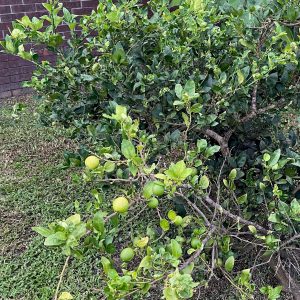
Key Lime fruit at various degrees of ripeness. Photo courtesy of Ray Bodrey, UF/IFAS Extension Gulf County.
Climate is an important factor when deciding to plant a key lime. They are sensitive to cold temperatures, especially below freezing. For the Panhandle, it’s wise to keep key lime trees as patio citrus. In other words, keep the trees in pots so that they can be moved indoors for protection during the winter months. In the ground, trees should be planted in an area where there is a significant wind block. Once a few years have passed and tree has become more mature and acclimated to the environment, they may be able to survive on their own, though it is recommended to cover the tree under sub-freezing temperatures. However, it is important to remember that sunlight is a catalyst for citrus fruit production, be sure to plant the tree in an area with full sun.
The usual suspects of citrus insect pests apply to the key lime also. Citrus leaf miner and mites are the most common culprits. Horticultural and insecticidal oils will certainly help to combat these threats. For planting, key lime is well adapted to a variety of soil conditions in Florida. Be sure to water newly planted trees every other day for the first week and then one to two times a week for the first couple of months. Water periodically after that, making sure the soil doesn’t stay completely dry for long periods. A 6-6-6 fertilizer works great for the key lime. Please follow the fertilizer schedule found in the UF/IFAS EDIS publication, “Citrus Culture in the Home Landscape” by Robert E. Rouse and Mongi Zekri: https://edis.ifas.ufl.edu/pdf/HS/HS132/HS132-11822781.pdf
A final interesting thing about the key lime is the ripening stages of the fruit. Because key limes are ever-bearers, blooms can develop at sometimes widely varying times. This causes an uneven development of fruit across the tree. Be sure to wait until the fruit turns begins to turn yellow before harvest. That’s when it’s mature to eat! Fruit can be stored for up to a week in the fridge or can be juiced and stored in the freezer for later use.
Please contact your local county Extension office for more information. Happy Gardening!
Information for this article can be found in the UF/IFAS EDIS publication, “Key Lime Growing in the Florida Home Landscape” by Jonathan H. Crane: https://edis.ifas.ufl.edu/publication/CH092
UF/IFAS Extension is an Equal Opportunity Institution.
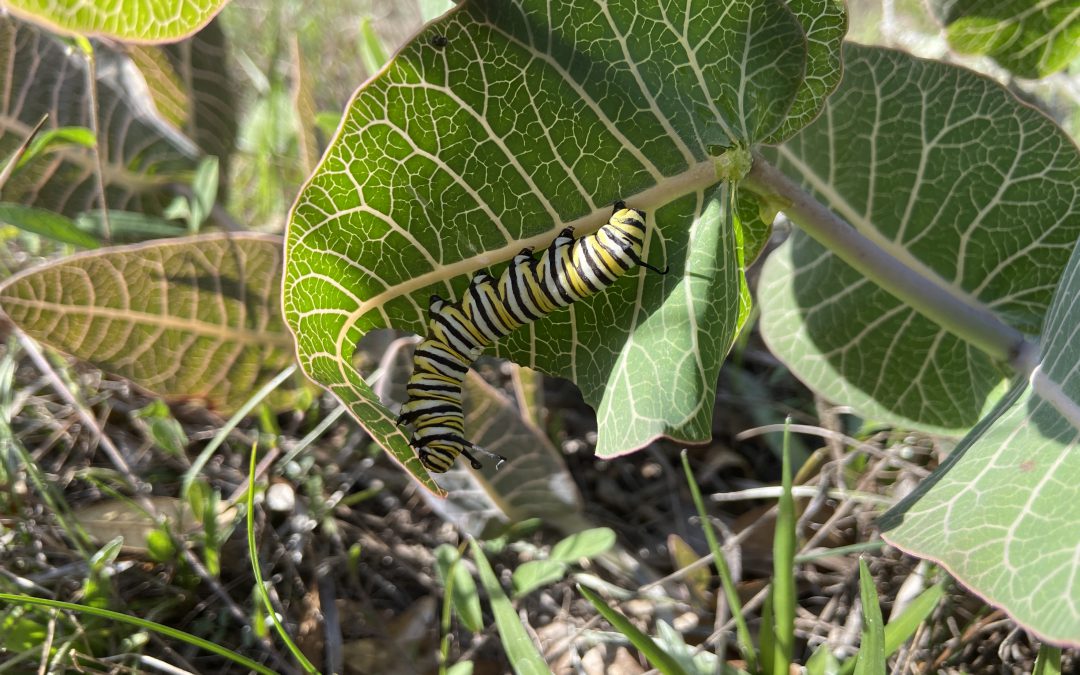
by Mary Salinas | Aug 20, 2021
On August 12, 2021, our panel answered questions on a wide variety of landscape topics. Maybe you are asking the same questions, so read on!
Ideas on choosing plants
What are some perennials that can be planted this late in the summer but will still bloom through the cooler months into fall?
Duranta erecta ‘Sapphire Showers’ or ‘Gold Mound’, firespike, Senna bicapsularis, shrimp plant, lion’s ear
Where can native plants be obtained?
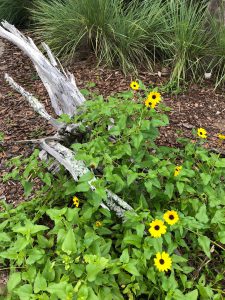
Dune sunflower, Helianthus debilis. Photo credit: Mary Salinas UF/IFAS Extension.
Gardening Solutions: Florida Native Plants – see link to FANN: https://gardeningsolutions.ifas.ufl.edu/plants/ornamentals/native-plants.html
What are some evergreen groundcover options for our area?
Mondo grass, Japanese plum yew, shore juniper, ajuga, ferns such as autumn fern.
What are some ideas for partial morning sun butterfly attracting tall flowers to plant now?
Milkweed, salt and pepper plant, swamp sunflower, dune sunflower, ironweed, porterweed, and salt bush.
I’m interested in moving away from a monoculture lawn. What are some suggestions for alternatives?
Perennial peanut, powderpuff mimosa, and frogfruit.
We are new to Florida and have questions about everything in our landscape.
Florida-Friendly-Landscaping TM Program and FFL Web Apps: https://ffl.ifas.ufl.edu/
https://ffl.ifas.ufl.edu/resources/apps/
UF IFAS Gardening Solutions: https://gardeningsolutions.ifas.ufl.edu/
What are some of the top trends in landscaping today?
Houseplants, edible gardens, native plants, food forests, attracting wildlife, container gardening, and zoysiagrass lawns
Edibles
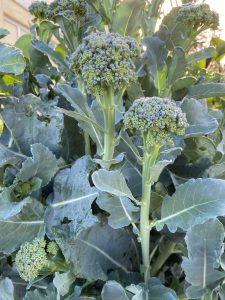
Artwork broccoli is a variety that produces small heads. Photo credit: Mary Salinas UF/IFAS Extension.
What vegetables are suitable for fall/winter gardening?
Cool Season Vegetables: https://gardeningsolutions.ifas.ufl.edu/plants/edibles/vegetables/cool-season-vegetables.html
North Florida Gardening Calendar: https://edis.ifas.ufl.edu/publication/EP451%20%20%20
Florida Vegetable Gardening Guide: https://edis.ifas.ufl.edu/publication/vh021
How can I add herbs to my landscape?
Herbs in the Florida Garden: https://gardeningsolutions.ifas.ufl.edu/plants/edibles/vegetables/herbs.html
My figs are green and hard. When do they ripen?
Why Won’t My Figs Ripen: https://www.lsuagcenter.com/profiles/rbogren/articles/page1597952870939
What is best soil for raised bed vegetable gardens?
Gardening in Raised Beds: https://edis.ifas.ufl.edu/publication/EP472
And there are always questions about weeds
How can I eradicate cogongrass?
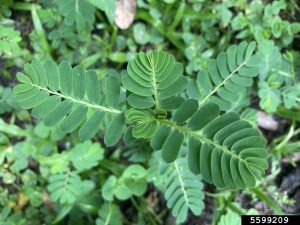
Chamber bitter is a troublesome warm season weed in our region. Photo credit: Brantlee Spakes Richter, University of Florida, Bugwood.org
Cogongrass: https://edis.ifas.ufl.edu/publication/WG202
Is it okay to use cardboard for weed control?
The Cardboard Controversy: https://gardenprofessors.com/the-cardboard-controversy/
What is the best way to control weeds in grass and landscape beds?
Weed Management Guide for Florida Lawns: https://edis.ifas.ufl.edu/publication/EP141
Improving Weed Control in Landscape Planting Beds: https://edis.ifas.ufl.edu/pdf/EP/EP52300.pdf
Landscape practices
Can ground water be brackish and stunt plants?
Reclaimed Water Use in the Landscape: https://edis.ifas.ufl.edu/publication/ss545
How can I prevent erosion from rainwater runoff?
Stormwater Runoff Control – NRCS: https://www.nrcs.usda.gov/wps/portal/nrcs/detail/national/water/?cid=nrcs144p2_027171
Rain Gardens: https://gardeningsolutions.ifas.ufl.edu/design/types-of-gardens/rain-gardens.html
And https://gardeningsolutions.ifas.ufl.edu/pdf/articles/rain-garden-manual-hillsborough.pdf
What is the best time of the year to propagate flowering trees in zone 8B?
Landscape Plant Propagation Information Page – UF/IFAS Env. Hort: https://hort.ifas.ufl.edu/database/lppi/
Which type of mulch works best on slopes greater than 3 percent?
Landscape Mulches: How Quickly do they Settle?: https://edis.ifas.ufl.edu/publication/FR052
When should bulbs be fertilized?
Bulbs and More – UI Extension: https://web.extension.illinois.edu/bulbs/planting.cfm
Should I cut the spent blooms of agapanthus?
Agapanthus, extending the bloom time: https://gardeningsolutions.ifas.ufl.edu/plants/ornamentals/agapanthus.html
http://blogs.ifas.ufl.edu/wakullaco/2020/10/07/extending-bloom-time/
Plant questions
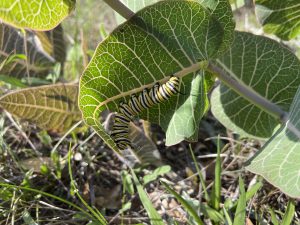
Monarch caterpillar munching on our native sandhill milkweed, Asclepias humistrata. Photo credit: Mary Salinas, UF IFAS Extension.
I planted native milkweed and have many monarch caterpillars. Should I protect them or leave them in nature?
It’s best to leave them in place. Featured Creatures: Monarch Butterfly: https://edis.ifas.ufl.edu/pdf/IN/IN780/IN780-Dxyup8sjiv.pdf
How does Vinca (periwinkle) do in direct sun? Will it make it through one of our panhandle summers? Can I plant in late August?
Periwinkles and No more fail with Cora series: https://gardeningsolutions.ifas.ufl.edu/plants/ornamentals/periwinkles.html#:~:text=Plant%20your%20periwinkles%20where%20they,rot%20if%20irrigated%20too%20frequently.
Insect and disease pests
What to do if you get termites in your raised bed?
The Facts About Termites and Mulch: https://edis.ifas.ufl.edu/publication/IN651
How to combat fungus?
Guidelines for ID and Management of Plant Disease Problems: https://edis.ifas.ufl.edu/publication/mg442
Are there preventative measures to prevent diseases when the humidity is very high and it is hot?
Fungi in Your Landscape by Maxine Hunter: http://blogs.ifas.ufl.edu/marionco/2020/01/16/fungi-in-your-landscape/
If you missed an episode, check out our playlist on YouTube https://www.youtube.com/watch?v=bp0HfdEkIQw&list=PLhgoAzWbtRXImdFE8Jdt0jsAOd-XldNCd

by Larry Williams | Jul 15, 2021
Q. One of my two fig trees has produced a few figs. The other one, which is the largest and healthiest tree, has never had a fig on it. Both where planted six years ago. Why is it not producing?
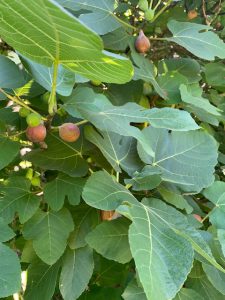
Mature fig tree with fruit. Photo credit: Larry Williams
A. It may be a matter of age and being overly vigorous. When a fruit tree is younger, it puts most of its energy into producing leaves and shoots. Until the plant becomes mature and slows down in the production of leaves and shoots, it will produce few to no fruit. It may take a year or two more for your tree to slowly and gradually switch from producing mostly leaves and shoots to producing and maturing some fruit. Patience is needed.
Be careful to not overdo it in fertilizing and/or pruning your fig tree. Too much fertilizer, especially nitrogen, or severely pruning the tree will result in the tree becoming overly vigorous at the expense of setting and maturing fruit. This includes fertilizer that the tree may pull up from a nearby lawn area. A tree’s roots will grow outward two to three times beyond its branch spread into adjacent lawn areas.
The end result of being heavy handed with fertilizing and/or overdoing it in pruning is the same – it forces the plant to become overly vigorous in producing leaves and shoots at the expense of producing and maturing fruit.
In addition, the following is taken from an Extension publication on figs and includes the most common reasons for lack of fruiting, in order of importance.
- Young, vigorous plants and over-fertilized plants will often produce fruit that drops off before maturing. If plants are excessively vigorous, stop fertilizing them. Quite often, three of four years may pass before the plant matures a crop because figs have a long juvenile period before producing edible quality fruit.
- Dry, hot periods that occur before ripening can cause poor fruit quality. If this is the case, mulching and supplemental watering during dry spells will reduce the problem.
- The variety Celeste will often drop fruit prematurely in hot weather regardless of the quality of plant care. However, it is still a good variety to grow.
- An infestation of root-knot nematodes can intensify the problem when conditions are as described in item 2.
- You could have a fig tree that requires cross-pollination by a special wasp. This is a rare problem. If this is the case, then it will never set a good crop. The best way to resolve this is to replace the plant with a rooted shoot of a neighbor’s plant you know produces a good crop each year.
















